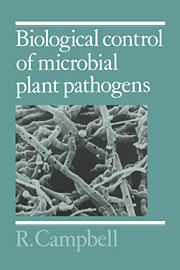Book contents
- Frontmatter
- Contents
- Preface
- 1 Introduction to plant pathology and microbial ecology
- 2 Historical and commercial background and methodology of biological control
- 3 Biocontrol on leaf surfaces
- 4 Biocontrol of stem diseases
- 5 Biocontrol of diseases of roots
- 6 Biocontrol of diseases of flowers and fruit
- 7 Biocontrol of diseases of seeds and seedlings
- 8 Conclusions and perspectives
- Glossary
- References
- Expanded index of pathogens
- Expanded index of antagonists
- Subject index
1 - Introduction to plant pathology and microbial ecology
Published online by Cambridge University Press: 02 December 2009
- Frontmatter
- Contents
- Preface
- 1 Introduction to plant pathology and microbial ecology
- 2 Historical and commercial background and methodology of biological control
- 3 Biocontrol on leaf surfaces
- 4 Biocontrol of stem diseases
- 5 Biocontrol of diseases of roots
- 6 Biocontrol of diseases of flowers and fruit
- 7 Biocontrol of diseases of seeds and seedlings
- 8 Conclusions and perspectives
- Glossary
- References
- Expanded index of pathogens
- Expanded index of antagonists
- Subject index
Summary
Introduction
The study of agricultural microbiology has expanded in recent years and one of the areas of particular interest has been biological control. The aim of this book is to provide an introduction for undergraduate students, or for research workers in related subjects, to the biological control of plant pathogens, especially of agricultural crops. The subject overlaps with the study of microbial inoculants that may be commercially available (e.g. Rhizobium) or still in the development stage like those for some mycorrhizas. Indeed the problem with biological control is that it impinges on so many other subjects because the approach is always holistic: it tries to combine the manipulation of edaphic and microclimatic factors with crop husbandry, plant breeding and direct intervention with microbial inoculants to produce maximum plant growth and minimum disease. This practical, commercial bias with agricultural crops has become dominant, but biological control does of course originate in natural ecosystems where in general serious disease is the exception and pathogens are supposed to have co-evolved and to exist in balance with their higher plant host and with the other microorganisms in their environment.
Biological ways of controlling disease have therefore existed for as long as hosts and plant pathogens, and they have been the only way of disease limitation until the last few years when chemicals became available. Lime sulphur was introduced in 1802 and Bordeaux mixture in 1882. This very recent advent of pesticides, like many other new ‘fashions’, has led to a temporary over-reaction and their over-use in some situations.
- Type
- Chapter
- Information
- Biological Control of Microbial Plant Pathogens , pp. 1 - 40Publisher: Cambridge University PressPrint publication year: 1989



